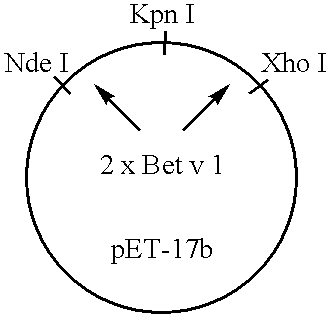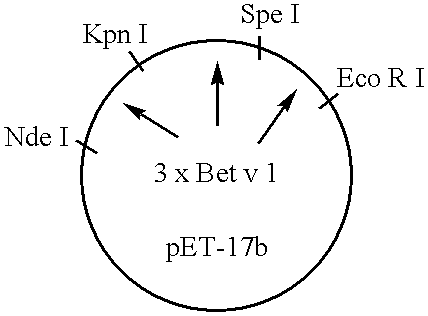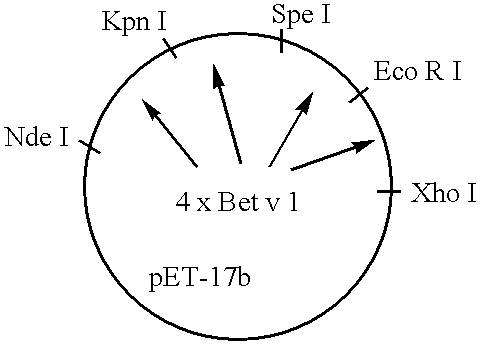Non-anaphylactic forms of allergens and their use
- Summary
- Abstract
- Description
- Claims
- Application Information
AI Technical Summary
Benefits of technology
Problems solved by technology
Method used
Image
Examples
example 2
Mapping the Binding Site of Antibodies in Bet v 1
[0077] Figure 8: Two monoclonal anti-Bet v 1-antibodies (moAb A and B) were used together with three synthetic Bet v 1-derived peptides were used in ELISA. The sequences of th three peptides are shown in the lower part of the figure and corresponds to aa 49-60 (p17), aa 52-63 (p118) and aa 55-66 (p19) of Bet v 1. The peptides were tested for binding to the two Bet v 1 specific monoclonals. The OD values are displaed on the y-axis. Both moAbs bind to the peptides p18 and p19, which are mapped to the first half of Bet v 1.
[0078] Table 3. The full table is given at the end of the descriptive part. Monoclonal anti-Bet v 1 antibodies (A,B) inhibit binding of human IgE to recombinant Bet v 1. Dot-blotted Bet v 1 was preincubated with MoAb A and B prior to probing with serum IgE from 60 Bet v 1 allergic individuals. Bound IgE was detected with 125I-labelled anti-human IgE antibodies and quantified by gamma-counting. Inhibition of IgE binding...
example 3
[0082] EXAMPLE 3
Two Non-anaphylactic Recombinant Fragments Bet v 1
[0083] See further Vrtala et al., "Conversion of the major birch pollen allergen, Bet v 1, into two non-anaphylactic T cell epitope containing fragments", J. Clin. Invest. 99(7) April 1997) 1673-1681.
Methods
[0084] Sera from allergic patients, antibodies, protein extracts and E. coli strains. Sera from birch pollen allergic patients and control individuals were characterized by RAST and testing with recombinant allergens as described (Valenta et al., J. Allergy Clin. Immunol. 88 (1991) 889-894; Valenta etal., Int. Arch. Allergy Immunol. 97 (1992) 287-294). In addition all patients were characterized by case history and skin pricl test. The mouse monoclonal antibody moab 14 with specificity for aa 40-65 of Bet v 1 is described (Lebecque et al., J. Allergy Clin. Immunol. in press). Natural birch pollen extract was prepared as described (Vrtala et al., Int. Arch. Allergy Immunol. 102 (1993) 160-169). Plasmid pET-17b conta...
PUM
| Property | Measurement | Unit |
|---|---|---|
| Hydrophilicity | aaaaa | aaaaa |
Abstract
Description
Claims
Application Information
 Login to View More
Login to View More - R&D
- Intellectual Property
- Life Sciences
- Materials
- Tech Scout
- Unparalleled Data Quality
- Higher Quality Content
- 60% Fewer Hallucinations
Browse by: Latest US Patents, China's latest patents, Technical Efficacy Thesaurus, Application Domain, Technology Topic, Popular Technical Reports.
© 2025 PatSnap. All rights reserved.Legal|Privacy policy|Modern Slavery Act Transparency Statement|Sitemap|About US| Contact US: help@patsnap.com



